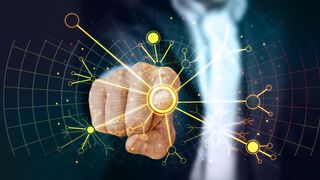Contact tracing technology: how does it work?
What testing entails

The government is looking at the NHS contact tracing app as being key to eventually moving out of the lockdown. During the pandemic, contact tracing technology aims to track down anyone that sufferers have been in prolonged contact with, with a view of potentially asking them to self-isolate. It works by using Bluetooth signals which log when smartphone owners are close to one another. Therefore, if someone develops COVID-19 symptoms, an alert can be sent to others they may have infected.
Henri Kujala is Global Data Privacy Officer at HERE Technologies.
Contact tracing has been credited with helping to lift restrictions in other countries, thanks to strategies of extensive tracking combined with mass testing. To this extent, it’s a good sign that the NHS is in advanced stages of its testing, with its app expected sometime this month.
However, to make sure this app is accurate and fulfills its purpose, and misconceptions around our privacy are dispelled, there are crucial elements that must be considered.
What will testing entail?
Bluetooth is logistically the best solution for contact tracing. But, as with any technologies, there are issues with Bluetooth that will need some rectifying before the app is released to the general public.
To begin with, as a technology, Bluetooth is rather weak at providing context. It can detect another phone within its vicinity, but it can’t pinpoint the direction that person is coming from. In other words, it is unable to distinguish between horizontal and vertical distances. This means that a Bluetooth-based app might categorize two people in the same building as having been in contact with each other, even if they were on different floors.
Bluetooth does not provide timely context either. A tracing app based on Bluetooth would only warn people who might have shared a lift with an infected person if they took the lift together, and not if they had taken the same lift one after the other. But the lift could contain traces of the virus on its surfaces, so should therefore be considered as a relay for infections.
The problem of interference
Furthermore, interference can prevent two phones from detecting each other within a distance of two metres, implying that many matches could be missed while others could be recorded by mistake. Current testing is working to overcome these issues in order to better locate the direction in which a signal is sent to a phone, as well as looking into alternatives to minimize potential interference.
Are you a pro? Subscribe to our newsletter
Sign up to the TechRadar Pro newsletter to get all the top news, opinion, features and guidance your business needs to succeed!
From a technical standpoint, the technology is also difficult to implement. For contact tracing to work efficiently, the Bluetooth function would have to be operational all the time in order to allow for data broadcasting and receiving. This would drain the phone’s battery quickly, defeating the app’s main goal: tracing contact between people, all the time.
Bluetooth LE (low energy) is the required solution for this – something that the NHS has confirmed it is testing. But going forward, device manufacturers might have a role to play in driving change to tackle the power usage issue, as Bluetooth chips can differ from one another depending on the model of the device.
Understanding privacy
The discussion around tracing technology has become polarized, with the fear of compromising citizens’ privacy on the one hand, and the need to reduce the spread of the virus as the lockdown is progressively lifted on the other.
The NHS app will guarantee the privacy of citizens in that it will be downloaded on a voluntary basis and its use will be limited to a specific timeframe. Based on Bluetooth technology, it will focus on the proximity of people to one another rather than on their specific location.
The current discussions around privacy implications come from whether contact tracing apps will use a centralized system. This means that the matching process happens on a computer server rather than being confined to the device itself. Some tech companies have proposed apps where the contact tracing data will stay on the device as part of a decentralized system, which they believe limits the possibility of a breach.
On the other hand, the NHS has opted for a centralized model so that it can adapt faster as more data about the virus is accumulated, though it will naturally need to go to substantial lengths to ensure this remains secure. It also has not ruled out moving towards a decentralized model in the future, if necessary. Both methods have their pros and cons, but ultimately share the desired outcome of minimizing the virus spread.
What location intelligence can offer
While contact tracing has been in the spotlight rather a lot recently, there are many more things location intelligence, which encompasses Bluetooth technology, can do to help tackle the spread of the virus.
Location intelligence can highlight hotspots of infected people if used in self-reporting apps where people voluntarily describe their symptoms and are advised accordingly. This is occurring with the COVID Symptom Tracker app, created by researchers and scientists to encourage people to share their daily symptoms – even if it’s the case of stating no symptoms – to collect data on how the virus is spreading and show hotspots around the UK.
The technology can also bring different groups of people together in terms of support, such as connecting volunteers with elderly people to help with their shopping. Combined with supply chain information and data, it can help people determine where sought-after products are available and how busy a shop might be.
With ventilators, a much-needed resource during the pandemic, location intelligence can be used to track and distribute them in an optimal way according to the number of patients per hospital per location.
COVID-19 has been classed as the most visualized pandemic of all time. Never before during a global pandemic has there been access to advanced technology like there is today. Location data made it possible to map the spread of the virus from the moment it began to spread across China – and now keeps the public up to date on how it’s continuing to spread across the globe. Mobility flows of people across regions have also been mapped with the intention of enabling a progressive lift of lockdown measures.
Next steps
The NHS app is likely to be used by millions across the UK, with over half of the population of the Isle of Wight having downloaded it during its trial. It will be instrumental in determining how lockdown measures are lifted, through identifying the proximity of infected people to one another.
Not only does this show how the power of location intelligence can keep us safe but it also indicates how much potential technology has. The countries that were successful in containing the virus generally used technology as a substantial part of their strategy, while others have been quick to follow this lead. So, if another crises situation were to occur, technology will be ready and waiting.
- Working from home? We've featured the best office equipment for remote working.
Henri Kujala is Chief Privacy Officer at HERE Technologies.
He is passionate about privacy with the right understanding on how to ensure privacy is a business enabler and not a blocker. He sees an opportunity in every challenge, goes and tackles them. He has an uncommon skill set: in-depth understanding of the global privacy regulation combined with technology and solution understanding. This enables him to not just turn privacy requirements into implementable stories and features for R&D, but also to ensure privacy is actually implemented in running code and solutions.

